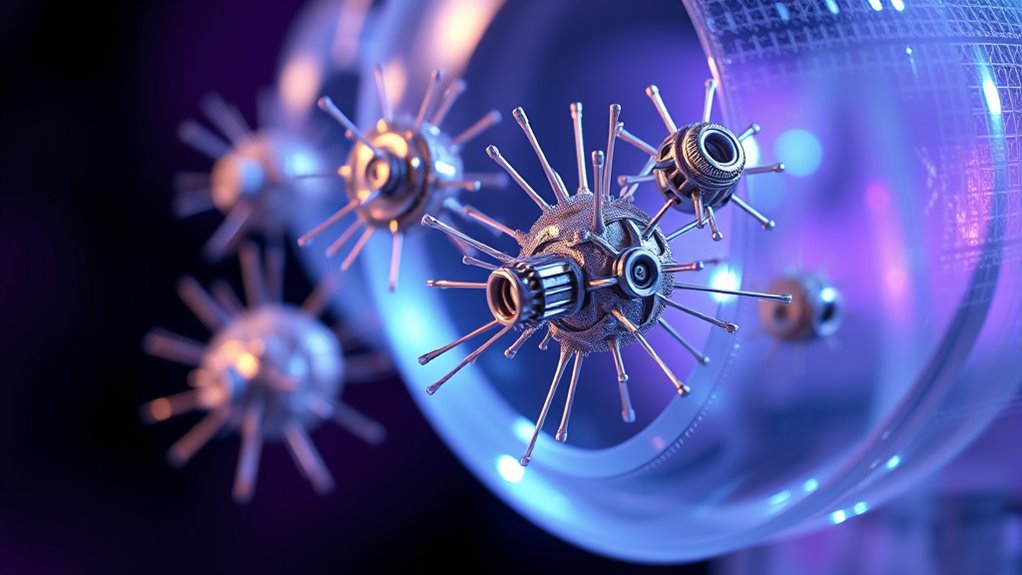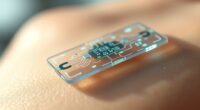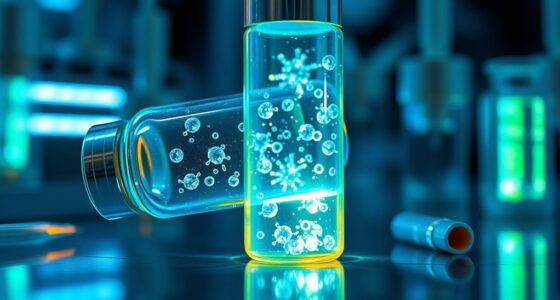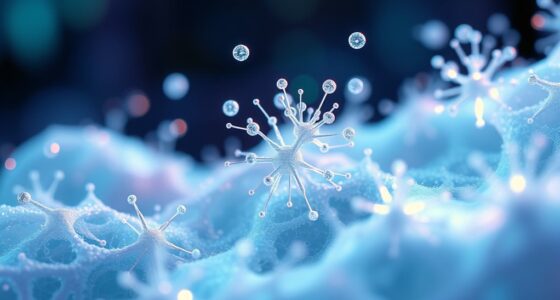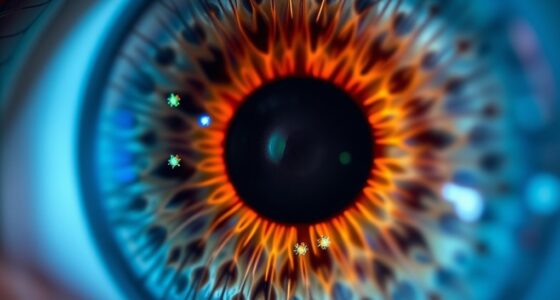Nanomachines in drug delivery are tiny devices designed to target specific cells or tissues, ensuring treatments are more precise and less invasive. They navigate complex biological environments, recognize disease markers, and release therapeutics exactly where needed. This approach minimizes side effects and enhances effectiveness. If you’re curious about how these innovations are transforming healthcare, you’ll discover more about their design, challenges, and future potential as you explore further.
Key Takeaways
- Nanomachines enable precise targeting of drugs to specific cells or tissues, reducing side effects.
- They can navigate biological barriers like blood vessels and cell membranes to reach disease sites.
- Engineered to recognize molecular markers, nanomachines improve the specificity of drug delivery.
- They provide controlled release of therapeutic agents, enhancing treatment effectiveness.
- Ongoing research focuses on developing biocompatible, durable nanomachines for safe medical applications.

Have you ever wondered how future medicine might target illness with pinpoint accuracy? It’s an exciting idea, and nanomachines are making it increasingly possible. These tiny devices, often just nanometers in size, can be engineered to navigate the complex environment of the human body, delivering drugs precisely where they’re needed. However, developing effective nanomachines isn’t without its hurdles. One of the most significant challenges is biocompatibility — guaranteeing these tiny machines don’t cause adverse reactions or immune responses when introduced into the body. Researchers must carefully select materials that are not only durable but also safe, so the nanomachines can perform their task without triggering inflammation or toxicity. Achieving this balance is vital for their success, especially since the body’s immune system is highly adept at identifying and attacking foreign objects.
Targeted delivery mechanisms are at the core of nanomachine technology. These mechanisms enable the nanomachines to recognize specific cell types, tissues, or even molecular markers associated with diseases. For example, if a cancer cell expresses unique surface proteins, nanomachines can be designed to detect and bind to those proteins, releasing their therapeutic payload directly into the malignant cells. This precision minimizes damage to healthy tissues and reduces side effects often seen with traditional treatments like chemotherapy. To accomplish this, scientists incorporate targeting ligands and sensors into the nanomachines, allowing them to respond to specific environmental cues. The ability to hone in on disease sites not only boosts treatment efficacy but also conserves resources by avoiding unnecessary drug dispersion throughout the body. Additionally, advances in data analytics help optimize the design and function of these nanomachines for better targeting and efficiency.
Designing nanomachines that can traverse biological barriers adds another layer of complexity. They must navigate through blood vessels, cross cell membranes, and sometimes even penetrate the blood-brain barrier, all while maintaining stability and functionality. This requires sophisticated engineering to assure they are resilient to the body’s harsh conditions yet responsive enough to release drugs on cue. The integration of targeted delivery mechanisms with biocompatibility considerations creates a delicate balance: the nanomachines must be effective in reaching their destination without provoking harmful immune responses. Overcoming these challenges demands ongoing innovation in materials science, molecular engineering, and nanotechnology. As research progresses, it’s becoming clearer that these tiny devices could revolutionize medicine by providing treatments that are not only more effective but also tailored to individual patients’ needs. With each breakthrough, the vision of highly precise, minimally invasive therapies moves closer to reality, promising a future where illness is attacked at its very source with unmatched accuracy.
Frequently Asked Questions
What Are the Main Challenges in Nanomachine Manufacturing?
You face several challenges in nanomachine manufacturing, especially with scalability issues and material stability. Scaling up production while maintaining precision can be tough, as small errors become bigger problems. Additionally, ensuring the materials stay stable under various conditions is vital to prevent malfunction. Overcoming these hurdles requires innovative techniques and rigorous testing, but addressing them is essential for creating reliable, effective nanomachines for medical and industrial uses.
How Do Nanomachines Target Specific Cells or Tissues?
A wise man once said, “The devil is in the details.” You can achieve precise cell targeting and tissue specificity by designing nanomachines with surface ligands or antibodies that recognize unique markers on specific cells. These nanomachines then bind selectively, delivering drugs directly where needed. This approach minimizes side effects and increases efficiency, making targeted therapy more effective and personalized.
Are There Any Known Side Effects of Nanomachines in Humans?
You might experience some potential immune responses or toxicity concerns with nanomachines in humans. While they’re designed to be safe, your body could react unpredictably, causing inflammation or allergic reactions. Researchers are still studying long-term effects, so it’s essential to monitor for any adverse reactions. Overall, although promising, nanomachines’ side effects are not fully understood yet, and ongoing research aims to minimize these risks.
What Is the Cost Comparison Between Nanomachines and Traditional Drugs?
You might find nanomachines currently costlier than traditional drugs due to advanced technology, complex manufacturing, and research expenses. A thorough cost analysis shows that while initial costs are high, nanomachines could reduce long-term expenses through targeted delivery and fewer side effects. Affordability considerations include production scale, technological advancements, and healthcare savings, making nanomachines a promising but more expensive option now, with potential for lower costs as technology matures.
How Long Do Nanomachines Remain Effective Inside the Body?
Nanomachines typically remain effective inside your body for a period dictated by their biodegradation rate and clearance time. Usually, they stay active for a few hours to days before breaking down or being cleared by your immune system. Factors like material composition and design influence this duration, ensuring they work long enough to deliver treatment but don’t linger unnecessarily, reducing potential side effects.
Conclusion
Imagine nanomachines as tiny navigators inside your body, expertly delivering medicine right where it’s needed. They’re like microscopic messengers, slicing through obstacles with precision and grace, transforming healthcare into a targeted art. As these tiny warriors continue to evolve, they hold the promise of revolutionizing treatment, making cures faster and more effective. Soon, your body will become a battlefield where nanomachines fight for your health, turning science fiction into life-saving reality.
